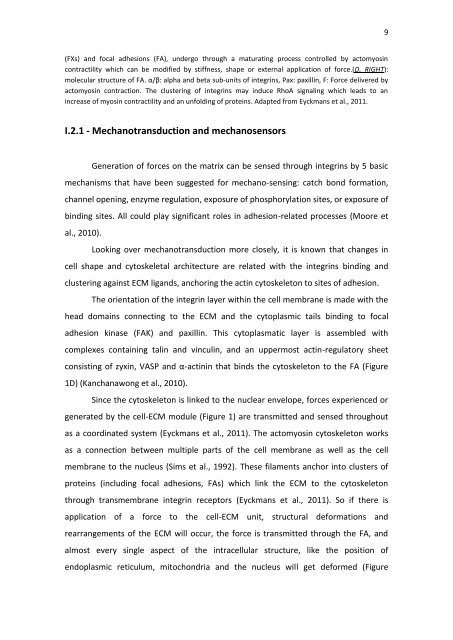DEPARTAMENTO DE CIÊNCIAS DA VIDA ... - Estudo Geral
DEPARTAMENTO DE CIÊNCIAS DA VIDA ... - Estudo Geral
DEPARTAMENTO DE CIÊNCIAS DA VIDA ... - Estudo Geral
Create successful ePaper yourself
Turn your PDF publications into a flip-book with our unique Google optimized e-Paper software.
9<br />
(FXs) and focal adhesions (FA), undergo through a maturating process controlled by actomyosin<br />
contractility which can be modified by stiffness, shape or external application of force.(D, RIGHT):<br />
molecular structure of FA. α/β: alpha and beta sub-units of integrins, Pax: paxillin, F: Force delivered by<br />
actomyosin contraction. The clustering of integrins may induce RhoA signaling which leads to an<br />
increase of myosin contractility and an unfolding of proteins. Adapted from Eyckmans et al., 2011.<br />
I.2.1 - Mechanotransduction and mechanosensors<br />
Generation of forces on the matrix can be sensed through integrins by 5 basic<br />
mechanisms that have been suggested for mechano-sensing: catch bond formation,<br />
channel opening, enzyme regulation, exposure of phosphorylation sites, or exposure of<br />
binding sites. All could play significant roles in adhesion-related processes (Moore et<br />
al., 2010).<br />
Looking over mechanotransduction more closely, it is known that changes in<br />
cell shape and cytoskeletal architecture are related with the integrins binding and<br />
clustering against ECM ligands, anchoring the actin cytoskeleton to sites of adhesion.<br />
The orientation of the integrin layer within the cell membrane is made with the<br />
head domains connecting to the ECM and the cytoplasmic tails binding to focal<br />
adhesion kinase (FAK) and paxillin. This cytoplasmatic layer is assembled with<br />
complexes containing talin and vinculin, and an uppermost actin-regulatory sheet<br />
consisting of zyxin, VASP and α-actinin that binds the cytoskeleton to the FA (Figure<br />
1D) (Kanchanawong et al., 2010).<br />
Since the cytoskeleton is linked to the nuclear envelope, forces experienced or<br />
generated by the cell-ECM module (Figure 1) are transmitted and sensed throughout<br />
as a coordinated system (Eyckmans et al., 2011). The actomyosin cytoskeleton works<br />
as a connection between multiple parts of the cell membrane as well as the cell<br />
membrane to the nucleus (Sims et al., 1992). These filaments anchor into clusters of<br />
proteins (including focal adhesions, FAs) which link the ECM to the cytoskeleton<br />
through transmembrane integrin receptors (Eyckmans et al., 2011). So if there is<br />
application of a force to the cell-ECM unit, structural deformations and<br />
rearrangements of the ECM will occur, the force is transmitted through the FA, and<br />
almost every single aspect of the intracellular structure, like the position of<br />
endoplasmic reticulum, mitochondria and the nucleus will get deformed (Figure
















